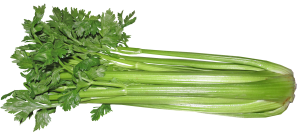
Celery is one of the most popular vegetables in the world and is used in cuisines around the globe. Its crunchy texture, mild flavor, and attractive green coloring make it a favorite for salads, soups, and accompaniments to main dishes. Celery is also a great source of vitamins, minerals, and dietary fiber.
Nutritional Benefits Of Celery
1. Low in Calories: Celery carries very few calories per serving, making it a great snack for those watching their waistlines. One cup of celery contains just 15 calories, while two stalks contain only 10 calories.
2. Rich in Vitamin K: Celery is an excellent source of Vitamin K, an essential nutrient for blood clotting and bone health. One cup of celery contains 20 percent of the recommended daily value of vitamin K.
3. High in Folate: Celery is a great source of folate, an essential B vitamin that plays an important role in cell growth and development. Folate is also needed for DNA replication and repair, and it is important for pregnant women to ensure they get enough folate from their diet.
4. High in Antioxidants: Celery is rich in antioxidants, which help protect the body from free radical damage and oxidative stress. It is especially high in the antioxidants luteolin, apigenin, and kaempferol, all of which have been studied for their potential anti-inflammatory and anti-cancer properties.
5. Rich in Fiber: Celery is a good source of dietary fiber, which can help keep digestion regular and promote a healthy gut. Fiber can also help lower cholesterol levels and control blood sugar levels.
6. Good Source of Potassium: Celery contains potassium, an important mineral for maintaining healthy blood pressure levels. Potassium also helps regulate fluid balance in the body and helps prevent muscle cramps.
7. High in Vitamins A and C: Celery is a good source of Vitamins A and C, which are important for healthy vision, skin, and immune system. Vitamin C helps the body absorb iron, while Vitamin A is essential for healthy bones and teeth.

History of Celery
The earliest known cultivation of celery can be traced back to the Egyptians and Greeks. The Greeks were the first to cultivate celery for its medicinal properties. They believed that celery could cure diseases and disorders of the stomach, heart, and lungs. They even prescribed celery as a remedy for hangovers!
The Romans also used celery in their cooking. They enjoyed celery as a side dish or as a garnish for various dishes. They also used celery in salads and soups. They even used celery leaves in their wine-making process, as they believed it added a unique flavor to the beverage.
In Europe, celery was grown in the Middle Ages. It was used in salads, soups, and other dishes. It was also used as a flavoring for various dishes and drinks, such as grog and beer.
In the 16th and 17th centuries, celery began to be grown in the United States. It was grown primarily in the Northeast, but it wasn’t until the 19th century that celery began to become cultivated on a larger scale. By the late 19th century, celery was being grown in California and other parts of the country.
Today, celery is grown in many parts of the world and is widely used in cooking. It is used in soups, salads, and as a garnish for various dishes. It is also used as a flavoring for various dishes and beverages, such as beer and grog.
Cooking with Celery
Celery is a vegetable that can be found in many kitchens, whether it’s used as a garnish, as a snack, or as a base for recipes. It’s versatile, easy to cook with, and can bring out the flavor of many dishes. Here are a few tips for cooking with celery and some delicious recipes to get you started.
To get the most flavor out of your celery, start by selecting fresh celery stalks. Look for thick, firm stalks with crisp leaves and no signs of yellowing or wilting. If you’re using the leaves, make sure they are crisp and green. Avoid any stalks with spots or bruises. Store celery in the refrigerator wrapped in a paper towel to help them stay fresh and crisp.
Before you start cooking, you’ll need to chop up the celery. Cut off the ends and slice the stalks into thin slices (1/4” thick or less). This will help it cook faster and more evenly. You can also dice it for soups and stews, or mince it for salads and other dishes.
Celery has a mild, slightly salty flavor, so it pairs well with other flavors. It’s especially delicious with onion, garlic, and herbs like thyme, oregano, and bay leaves. It’s also great with creamy sauces, like a cheese or cream sauce.
Celery can be cooked in a variety of ways. It’s delicious when sautéed or stir-fried in oil with other vegetables or meat. It can also be added to soups, stews, and casseroles. You can also bake it, braise it, or roast it in the oven.
Here are a few recipes to get you started cooking with celery.
Sautéed Celery and Onions: This is a classic combination and perfect for a side dish or a main dish. Heat a little olive oil in a large skillet over medium heat. Add the celery and onions and sauté until they are tender, about 8 minutes. Season with salt and pepper.
Celery Soup: This creamy soup is a great way to use up leftover celery. Start by sautéing onions and celery in butter or olive oil until they are soft. Add a little garlic, if desired. Add chicken broth and bring to a boil. Reduce heat and simmer for 10 minutes. Puree the mixture with an immersion blender. Add cream or milk and season with salt, pepper, and herbs, if desired. Serve warm.
Celery and Bacon: This is a classic combination perfect on top of a salad, mixed into a pasta dish, or served as a side dish. Start by cooking bacon in a skillet over medium heat until crispy. Remove the bacon from the skillet and set aside. Add the celery to the skillet and cook until it is tender and lightly browned. Add the bacon back to the skillet and season with salt and pepper.
Celery is a versatile vegetable that’s easy to cook with and can bring out the flavor of many dishes. Whether you’re making a classic soup, sautéing it with other vegetables, or using it in a salad or side dish, celery is a great addition to any dish. Try some of these recipes and get creative with your cooking with celery.
Clinical Studies on Celery
One of the most commonly studied benefits of celery is its anti-inflammatory properties. Inflammation can be a factor in a number of health conditions, including heart disease and arthritis. A study published in the journal ‘Phytotherapy Research’ found that celery extract was effective in reducing inflammation in mice. The researchers concluded that celery extract could be used as an anti-inflammatory agent.
In addition to its anti-inflammatory properties, celery has also been studied for its potential cardiovascular benefits. A study published in the journal Nutrition found that celery extract was able to lower both systolic and diastolic blood pressure in hypertensive rats. The study concluded that celery may be beneficial in the treatment of hypertension. Another study published in the journal ‘Molecular Medicine Reports’ found that celery extract was able to reduce the risk of atherosclerosis in mice, suggesting that celery may also be beneficial in reducing the risk of cardiovascular disease.
Celery has also been studied for its potential cancer-fighting properties. A study published in the journal ‘Nutrition and Cancer’ found that celery extract was able to reduce the growth of both breast cancer and prostate cancer cells in vitro. The study concluded that celery extract may be a promising natural cancer treatment.
In addition to its potential health benefits, celery is also a good source of dietary fiber, which is important for maintaining proper gut health. A study published in the journal ‘Nutrition & Metabolism’ found that celery was able to improve the composition of gut bacteria in rats, suggesting that celery may be beneficial in maintaining a healthy gut microbiome.